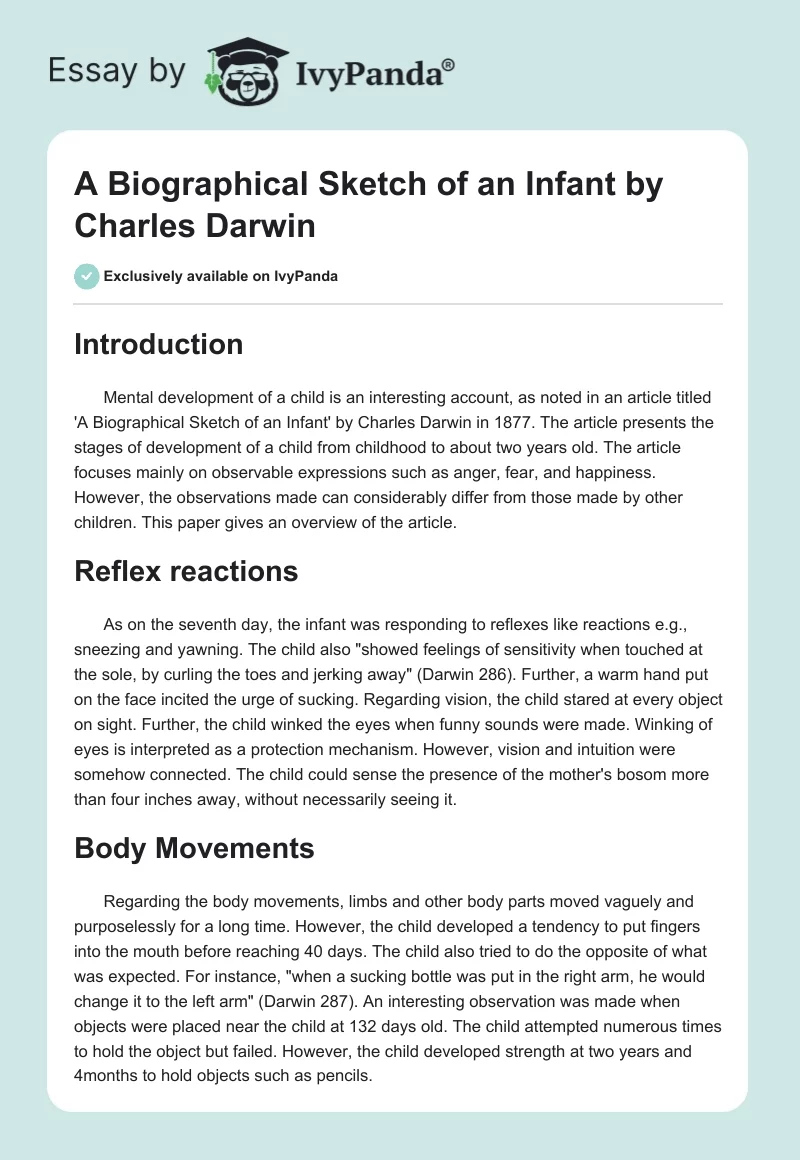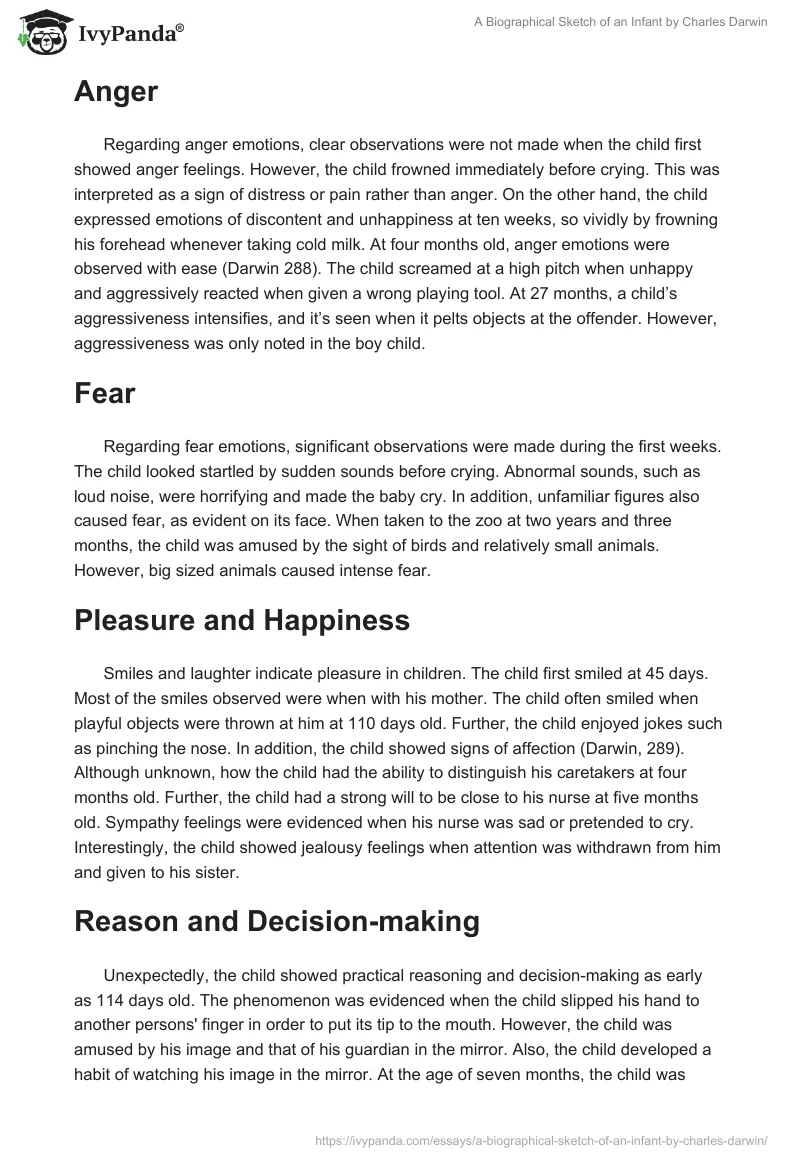Introduction
Mental development of a child is an interesting account, as noted in an article titled ‘A Biographical Sketch of an Infant’ by Charles Darwin in 1877. The article presents the stages of development of a child from childhood to about two years old. The article focuses mainly on observable expressions such as anger, fear, and happiness. However, the observations made can considerably differ from those made by other children. This paper gives an overview of the article.
Reflex reactions
As on the seventh day, the infant was responding to reflexes like reactions e.g., sneezing and yawning. The child also “showed feelings of sensitivity when touched at the sole, by curling the toes and jerking away” (Darwin 286). Further, a warm hand put on the face incited the urge of sucking. Regarding vision, the child stared at every object on sight. Further, the child winked the eyes when funny sounds were made. Winking of eyes is interpreted as a protection mechanism. However, vision and intuition were somehow connected. The child could sense the presence of the mother’s bosom more than four inches away, without necessarily seeing it.
Body Movements
Regarding the body movements, limbs and other body parts moved vaguely and purposelessly for a long time. However, the child developed a tendency to put fingers into the mouth before reaching 40 days. The child also tried to do the opposite of what was expected. For instance, “when a sucking bottle was put in the right arm, he would change it to the left arm” (Darwin 287). An interesting observation was made when objects were placed near the child at 132 days old. The child attempted numerous times to hold the object but failed. However, the child developed strength at two years and 4months to hold objects such as pencils.
Anger
Regarding anger emotions, clear observations were not made when the child first showed anger feelings. However, the child frowned immediately before crying. This was interpreted as a sign of distress or pain rather than anger. On the other hand, the child expressed emotions of discontent and unhappiness at ten weeks, so vividly by frowning his forehead whenever taking cold milk. At four months old, anger emotions were observed with ease (Darwin 288). The child screamed at a high pitch when unhappy and aggressively reacted when given a wrong playing tool. At 27 months, a child’s aggressiveness intensifies, and it’s seen when it pelts objects at the offender. However, aggressiveness was only noted in the boy child.
Fear
Regarding fear emotions, significant observations were made during the first weeks. The child looked startled by sudden sounds before crying. Abnormal sounds, such as loud noise, were horrifying and made the baby cry. In addition, unfamiliar figures also caused fear, as evident on its face. When taken to the zoo at two years and three months, the child was amused by the sight of birds and relatively small animals. However, big sized animals caused intense fear.
Pleasure and Happiness
Smiles and laughter indicate pleasure in children. The child first smiled at 45 days. Most of the smiles observed were when with his mother. The child often smiled when playful objects were thrown at him at 110 days old. Further, the child enjoyed jokes such as pinching the nose. In addition, the child showed signs of affection (Darwin, 289). Although unknown, how the child had the ability to distinguish his caretakers at four months old. Further, the child had a strong will to be close to his nurse at five months old. Sympathy feelings were evidenced when his nurse was sad or pretended to cry. Interestingly, the child showed jealousy feelings when attention was withdrawn from him and given to his sister.
Reason and Decision-making
Unexpectedly, the child showed practical reasoning and decision-making as early as 114 days old. The phenomenon was evidenced when the child slipped his hand to another persons’ finger in order to put its tip to the mouth. However, the child was amused by his image and that of his guardian in the mirror. Also, the child developed a habit of watching his image in the mirror. At the age of seven months, the child was amazed at seeing his guardian through the glass window. The guardian further noticed that the child had the ability to associate words with actions as early as five months old. This was evidenced by the mention of his nurse’s name. Every time the name was mentioned, the child would look around searching for her. Further, the guardian observed that at nine months old, the child had realized that any object causing a shadow was always behind.
Curiosity and Brain Development
As noted by M. Taine, curiosity leads to the development of brains in children. In this case, the guardian made no remarkable observation regarding the curiosity of the child. However, the child imitated sounds at four months old, and at eleven and a half months, the child could imitate almost all actions performed in front of him. In addition, the child had a good memory at three years and 23 days old, as evidenced when shown the picture of his grandfather. Although they had not met for six months, the child explained their last encounter vividly.
Moral Sense
The moral sense was first noted at the age of 13 months. At 13 months old, the child could protrude his lips, ready to get a kiss, and remained unmoved until it was given. Further, the child showed trickster characteristics by pretending to be angry in order to be given or give a kiss. However, the child was no different from other children. The form of drama common in other children was noted in this child. Ongoing to his room, the Guardian noted that the child had been eating sugar contrary to what he was told. Although the child had never been punished, the guardian noted that the odd look on the child’s face was due to fear of punishment.
Unconsciousness, Shyness, and Communication
Many children are known to be unconscious and shameless. This is noted by gazing at visitors for a long time without blinking. As the child grows, they become shy. The first sign of shyness was evidenced when the child was two years and three months old. In addition, different means of communication were noted when the child was eleven weeks old. Crying and squalling were the typical signs to show hunger, distress, and pain. Laughter was “first observed on the 113th day, although it is recorded much earlier in other children” (Darwin 293). At one-year-old, the child used gestures as a means of communication, such as pointing at objects. Interestingly, the child devised tonal variation when demanding for different things. For instance, when requesting for food, the words were interrogative.
Finally, a child expresses their needs through crying, screaming, or even gestures. A child also has a basic understanding of their guardians’ feelings through how they express them. When the “child was six months, he showed sympathy when his nurse pretended to cry” (Darwin 286). A child also develops the ability to relate the feelings of those around with what is happening.
Works Cited
Darwin, Charles. “A Biographical Sketch of an Infant.” Mind 2.2 (2015): 250-300. Web.


